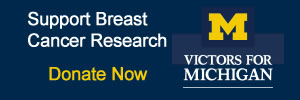Breast Cancer Risk Factors
A risk factor is anything that affects your chance of getting a disease, such as cancer. Most women who have one or more breast cancer risk factors never develop the disease, while many women with breast cancer have no apparent risk factors (other than being a woman and growing older). Even when a woman with risk factors develops breast cancer, it is hard to know just how much these factors may have contributed to her cancer.
There are different kinds of risk factors. Some factors, like a person's age or race, can't be changed. Others are linked to cancer-causing factors in the environment. Still others are to related personal behaviors, such as smoking, drinking, and diet. Some factors influence risk more than others, and your risk for breast cancer can change over time, due to factors such as aging or lifestyle.
Studies have found the following risk factors for breast cancer:
Risk factors you cannot change:
- Gender:
Simply being a woman is the main risk factor for developing breast cancer. Although women have many more breast cells than men, the main reason they develop more breast cancer is because their breast cells are constantly exposed to the growth-promoting effects of the female hormones estrogen and progesterone. Men can develop breast cancer, but this disease is about 100 times more common among women than men. - Aging:
Your risk of developing breast cancer increases as you get older. About 1 out of 8 invasive breast cancers are found in women younger than 45, while about 2 out of 3 invasive breast cancers are found in women age 55 or older. - Genetic risk factors:
About 5% to 10% of breast cancer cases are thought to be hereditary, resulting directly from gene defects (called mutations) inherited from a parent. Visit our Breast and Ovarian Risk Evaluation web pages for more information about genes and DNA. The most common cause of hereditary breast cancer is an inherited mutation in the BRCA1 and BRCA2 genes. - Family history of breast cancer:
Breast cancer risk is higher among women whose close blood relatives have this disease. Having one first-degree relative (mother, sister, or daughter) with breast cancer approximately doubles a woman's risk. Having 2 first-degree relatives increases her risk about 3-fold. - Race and ethnicity:
White women are slightly more likely to develop breast cancer than are African-American women. African-American women are more likely to die of this cancer. At least part of this seems to be because African-American women tend to have more aggressive tumors, although why this is the case is not known. Asian, Hispanic, and Native-American women have a lower risk of developing and dying from breast cancer. - Dense Breast Tissue:
Women with denser breast tissue (as seen on a mammogram) have more glandular tissue and less fatty tissue, and have a higher risk of breast cancer. Unfortunately, dense breast tissue can also make it harder for doctors to spot problems on mammograms. - Certain benign breast conditions:
Women diagnosed with certain benign breast conditions may have an increased risk of breast cancer. Some of these conditions are more closely linked to breast cancer risk than others. - Lobular carcinoma in situ:
Women with lobular carcinoma in situ (LCIS) have a 7- to 11-fold increased risk of developing cancer in either breast. - Menstrual periods:
Women who have had more menstrual cycles because they started menstruating at an early age (before age 12) and/or went through menopause at a later age (after age 55) have a slightly higher risk of breast cancer. This may be related to a higher lifetime exposure to the hormones estrogen and progesterone. - Previous chest radiation:
Women who, as children or young adults, had radiation therapy to the chest area as treatment for another cancer (such as Hodgkin disease or non-Hodgkin lymphoma) are at significantly increased risk for breast cancer. This varies with the patient's age when they had radiation. - Diethylstilbestrol exposure:
From the 1940s through the 1960s some pregnant women were given the drug diethylstilbestrol (DES) because it was thought to lower their chances of miscarriage (losing the baby). These women have a slightly increased risk of developing breast cancer. Women whose mothers took DES during pregnancy may also have a slightly higher risk of breast cancer.
Lifestyle-related factors and breast cancer risk:
- Having children:
Women who have had no children or who had their first child after age 30 have a slightly higher breast cancer risk. Having many pregnancies and becoming pregnant at a young age reduce breast cancer risk. Pregnancy reduces a woman's total number of lifetime menstrual cycles, which may be the reason for this effect. - Recent oral contraceptive use:
Studies have found that women using oral contraceptives (birth control pills) have a slightly greater risk of breast cancer than women who have never used them. This risk seems to decline back to normal over time once the pills are stopped. - Hormone therapy after menopause:
The increased risk from combined hormone therapy appears to apply only to current and recent users. A woman's breast cancer risk seems to return to that of the general population within 5 years of stopping combined treatment. - Breast-feeding:
Some studies suggest that breast-feeding may slightly lower breast cancer risk, especially if breast-feeding is continued for 1½ to 2 years. - Alcohol:
The use of alcohol is clearly linked to an increased risk of developing breast cancer. The risk increases with the amount of alcohol consumed. - Physical activity:
Evidence is growing that physical activity in the form of exercise reduces breast cancer risk.
Source: American Cancer Society (ACS) Learn About Breast Cancer webpage.

